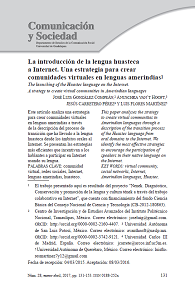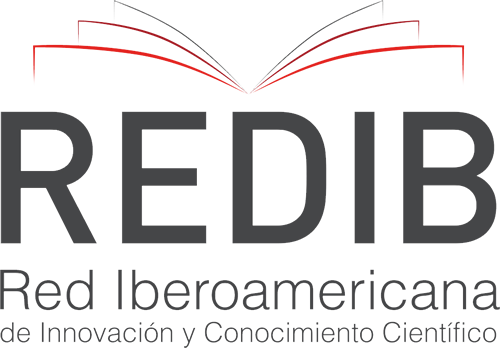La introducción de la lengua huasteca a Internet. Una estrategia para crear comunidades virtuales en lenguas amerindias
DOI:
https://doi.org/10.32870/cys.v0i28.6399Palabras clave:
Comunidad virtual, redes sociales, Internet, lenguas amerindias, huastecoResumen
Este artículo analiza una estrategia para crear comunidades virtuales en lenguas amerindias a través de la descripción del proceso de transición que ha llevado a la lengua huasteca desde los ámbitos orales al Internet. Se presentan las estrategias más eficientes que incentivan a los hablantes a participar en Internet usando su lengua.Descargas
Citas
Chang, A. M., Kannan, P. K. & Whinston, A. B. (1999). Electronic communities as intermediaries: The issues and economics. Proceedings of the 32nd Hawaii International Conference on System Sciences, 1-10. Recuperado el 8 de febrero de 2014 de https://www.computer.org/csdl/proceedings/hicss/1999/0001/05/00015041.pdf
Chiu, C. M., Hsu, M. H. & Wang, E. T. (Diciembre de 2006). Understanding knowledge sharing in virtual communities: An integration of social capital and social cognitive theories. Decision Support Systems, 42 (3), 1872-1888. DOI: 10.1016/j.dss.2006.04.001
Dempster, J. A., Beetham, H., Jackson, P. & Richardson, S. (2003). Creating virtual communities of practice for learning technology in higher education: Issues, challenges and experiences. The Journal for Association for Learning Technology, 11 (3), 103-117.
Flake, G. W., Lawrence, S. & Giles, C. L. (2000). Efficient identification of web communities. Proceedings of the 6th ACM SIGKDD conference, 150-160. DOI: 10.1145/347090.347121
García López, J. E., Vega Macías, D. & Martínez Herrera, M. A. (2004). Clasificación de localidades de México según grado de presencia indígena, 2000. México: Consejo Nacional de Población.
Flores Martínez, L. (2015). La lengua huasteca. Una comunidad en la nube. En S. Santos García (Coord.), Las lenguas en contacto. Español, inglés y lenguas mexicanas (pp. 87-97). Tepic, Nayarit, México: Universidad Autónoma de Nayarit.
Gómez Mont, C. (2015). Redes indígenas y lógicas de construcción de capital social en Internet. En R. Winocur Iparraguirre & J. A. Sánchez Martínez (Coords.), Redes sociodigitales en México (pp. 115-135). México: Consejo Nacional para la Cultura y las Artes/Fondo de Cultura Económica.
González Compeán, J. L. et al. (2012). Fault-Tolerant middleware based on multistream pipeline for private storage services. Proceedings of the International conference for Internet technology and secured transactions, 548-555.
González Compeán, J. L., Carretero Pereza, J., Sosa-Sosa, V., Rodríguez Cardoso, J. & Marcelín-Jiménez, R. (2013). An approach for constructing private storage services as a unified fault-tolerant system. Journal of Systems and Software, 86 (7), 1907-1922. DOI: 10.1016/j.jss.2013.02.056
Gupta, S. & Kim, H. W. (2004). Virtual community: Concepts, implications, and future research directions. Proceedings of the Tenth Americas Conference on Information Systems (pp. 2679-2687). Nueva York, EE.UU.
Hagel III, J. & Armstrong, A. J. (1997). NetGain. Expanding markets through virtual communities. Boston, MA, EE.UU.: Harvard Business School Press.
Instituto Nacional de Estadística y Geografía-INEGI. (2009). Perfil sociodemográfico de la población que habla lengua indígena. Aguascalientes, México: Autor.
Instituto Nacional de Estadística y Geografía-INEGI. (2010). Censo de Población y Vivienda 2010. Aguascalientes, México: Autor.
Li, H. (2004). Virtual community studies: A literature review, synthesis and research agenda. Proceedings of the Americas Conference on Information Systems, pp. 2708-2715.
Miller, A. J. (2014). Social informatics and virtual communities. A literature review. Learning and Performance Quarterly, 2 (2), 28-36.
Rheingold, H. (2000). The virtual community. Homesteading on the electronic Frontier (Revised Edition). Cambridge: MIT Press.
Van´t Hooft, A. & González Compeán, J. L. (2014). Collaborative language documentation: The construction of the Huastec corpus. Proceedings CCURL 2014. Collaboration and Computing for Under-Resourced Languages in the Linked Open Data Era. Workshop in the 9th Language Resources and Evaluation Conference (LREC 2014), Reykyavik, Islandia, 67-70.
Yang, T., Chi, Y., Zhu, S., Gong, Y. & Jin, R. (2011). Detecting communities and their evolutions in dynamic social networks -a Bayesian approach. Mach. Learning, 82 (2), 157-189.

Publicado
Cómo citar
Número
Sección
Licencia
Los autores/as que publiquen en esta revista aceptan las siguientes condiciones:
De acuerdo con la legislación de derechos de autor, los autores conservan los derechos de autoría y otorgan a Comunicación y Sociedad el derecho de primera comunicación pública de la obra. Comunicación y Sociedad no realiza cargos a los autores por enviar y procesar artículos para su publicación.
Los autores/as pueden realizar otros acuerdos contractuales independientes y adicionales para la distribución no exclusiva de la versión del artículo publicado en Comunicación y Sociedad (por ejemplo incluirlo en un repositorio institucional o publicarlo en un libro) siempre que indiquen claramente que el trabajo se publicó por primera vez en Comunicación y Sociedad.










